
The stories of Kumano - Heike & Kumano

The stories of Kumano - Heike & Kumano
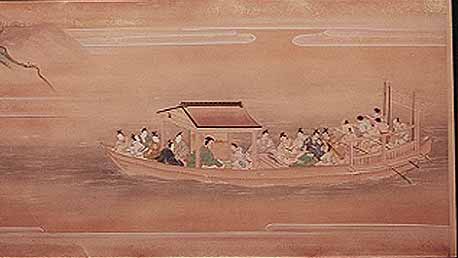 The Heike Monogatari (the story of the Tairano
Family) tells us that the prosperity of the Tairano
Family started not accidentally but rather because of the
power of the Kumano Gongen (Kumano Deity). While Kiyomori
of the Heike clan was making his pilgrimage journey to
Kumano by boat from Ise, a 'suzuki' (a sea bass) jumped
into his boat. This implied that he would receive the
power and support of the Suzuki family who were
influential in the Kumano Navy. Indeed it is said that
Kiyomori began his rise in the world soon after this
auspicious event. He proceeded to cook and eat this sea
bass with his family and servants. According to legend,
by eating this fish he thereafter was assisted by the
Kumano Gongen
The Heike Monogatari (the story of the Tairano
Family) tells us that the prosperity of the Tairano
Family started not accidentally but rather because of the
power of the Kumano Gongen (Kumano Deity). While Kiyomori
of the Heike clan was making his pilgrimage journey to
Kumano by boat from Ise, a 'suzuki' (a sea bass) jumped
into his boat. This implied that he would receive the
power and support of the Suzuki family who were
influential in the Kumano Navy. Indeed it is said that
Kiyomori began his rise in the world soon after this
auspicious event. He proceeded to cook and eat this sea
bass with his family and servants. According to legend,
by eating this fish he thereafter was assisted by the
Kumano Gongen 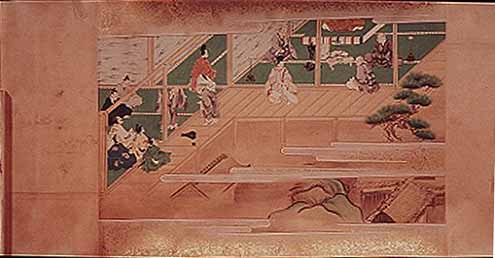 The prosperity of the Tairano Family was envied
by the emperor Goshirakawa, court nobles, and other
families. The Emperor Goshirakawa (who had made 33
pilgrimages to Kumano), the monk Shunkan, and others,
gathered at a mountain villa at Shishigatani in Kyoto and
conspired against the Tairano clan. But this leaked out
to Kiyomori, and all the conspirators were punished.
The prosperity of the Tairano Family was envied
by the emperor Goshirakawa, court nobles, and other
families. The Emperor Goshirakawa (who had made 33
pilgrimages to Kumano), the monk Shunkan, and others,
gathered at a mountain villa at Shishigatani in Kyoto and
conspired against the Tairano clan. But this leaked out
to Kiyomori, and all the conspirators were punished.  The participants of the Shishigatani Conspiracy
(except the former emperor) were all punished. Among the
people punished because of the Shishigatani Conspiracy
were Fujiwarano Naritsune, Tairano Yasuyori and the monk
Shunkan. All were banished to an isolated island called
Kikaigashima in the sea south of Kagoshima Prefecture.
Naritsune and Yasuyori were the devotees of the Kumano
Gongen, so they deified the Kumano Gongen on this island
and prayed to return home. Naritsune and Yasuyori found
the topography of the island similar to Kumano. When they
found a waterfall, they decided to worship the deity of
the Nachi Grand Shrine there, one mountain was Shingu and
another Hongu, and so on. Every day they would make their
mini Kumano Pilgrimage in order to pray for their
homecoming.
The participants of the Shishigatani Conspiracy
(except the former emperor) were all punished. Among the
people punished because of the Shishigatani Conspiracy
were Fujiwarano Naritsune, Tairano Yasuyori and the monk
Shunkan. All were banished to an isolated island called
Kikaigashima in the sea south of Kagoshima Prefecture.
Naritsune and Yasuyori were the devotees of the Kumano
Gongen, so they deified the Kumano Gongen on this island
and prayed to return home. Naritsune and Yasuyori found
the topography of the island similar to Kumano. When they
found a waterfall, they decided to worship the deity of
the Nachi Grand Shrine there, one mountain was Shingu and
another Hongu, and so on. Every day they would make their
mini Kumano Pilgrimage in order to pray for their
homecoming. 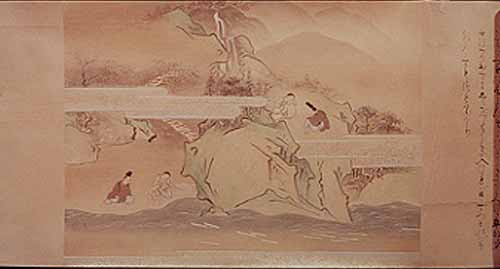 One day, when Fujiwareno Naritsune and Tairano
Yasuyori were on one of their mini Kumano pilgrimages,
they found a leaf of a nagi tree on the beach which is
the holly tree, a symbol of Kumano Gongen. They picked it
up and found that the worm-eaten patterns on the leaf
could read a poem saying, 'Because you pray to the god of
Kumano with such eagerness, you shall return'. The two
were very encouraged, so they wrote two poems along with
their names on 1000 stupas and set them adrift on the
sea. One of the thousand stupas was washed up on the
shore of Itsukushima Shrine in Miyajima, Aki (Hiroshima
Prefecture). The news of this incident spread as far as
Kyoto and people began to recite the poem of the Kumano
exiles.
One day, when Fujiwareno Naritsune and Tairano
Yasuyori were on one of their mini Kumano pilgrimages,
they found a leaf of a nagi tree on the beach which is
the holly tree, a symbol of Kumano Gongen. They picked it
up and found that the worm-eaten patterns on the leaf
could read a poem saying, 'Because you pray to the god of
Kumano with such eagerness, you shall return'. The two
were very encouraged, so they wrote two poems along with
their names on 1000 stupas and set them adrift on the
sea. One of the thousand stupas was washed up on the
shore of Itsukushima Shrine in Miyajima, Aki (Hiroshima
Prefecture). The news of this incident spread as far as
Kyoto and people began to recite the poem of the Kumano
exiles. 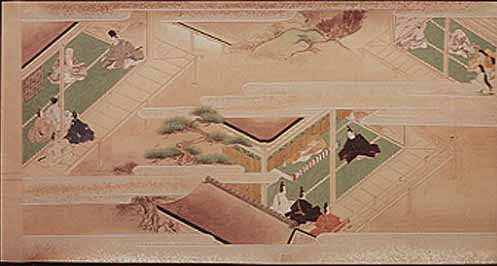 When Tokuko, the second daughter of Tairano
Kiyomori, who was also the wife to the Emperor Takakura,
got sick in bed while giving birth to her child, Tairano
Kiyomori became very concerned. He began to worry about
the consequences of his punishing his adversaries and
that his daughter's difficulties might be due to the bad
thoughts and energies being directed his way by his
adversaries and their families. At this time people
believed that both the spirit of the living and the dead
could affect the physical world. It was common sense to
be concerned about being possessed by evil spirits at the
time. He therefore decided to give amnesty so that his
daughter and child would not be possessed by them. Among
those who were given amnesty were Fujiwarano Naritsune
and Tairano Yasuyori. But Shunkan, who did not pray to
Kumano Gongen, was excepted from this amnesty. When the
boat came to fetch Naritsune and Yasuyori, Shunkan begged
in vain to have them take him to Kyushu. He was refused
and was left to live all alone on the island.
When Tokuko, the second daughter of Tairano
Kiyomori, who was also the wife to the Emperor Takakura,
got sick in bed while giving birth to her child, Tairano
Kiyomori became very concerned. He began to worry about
the consequences of his punishing his adversaries and
that his daughter's difficulties might be due to the bad
thoughts and energies being directed his way by his
adversaries and their families. At this time people
believed that both the spirit of the living and the dead
could affect the physical world. It was common sense to
be concerned about being possessed by evil spirits at the
time. He therefore decided to give amnesty so that his
daughter and child would not be possessed by them. Among
those who were given amnesty were Fujiwarano Naritsune
and Tairano Yasuyori. But Shunkan, who did not pray to
Kumano Gongen, was excepted from this amnesty. When the
boat came to fetch Naritsune and Yasuyori, Shunkan begged
in vain to have them take him to Kyushu. He was refused
and was left to live all alone on the island.  Shunkan had a disciple called Arioh. He spent
every day grieving since his master was banished. But one
day, he decided to go to Kikaigashima Island. Shunkan,
being left alone on the island, was overjoyed to see
Arioh. What Arioh saw when he arrived on the island was
Shunkan's withered and dying figure. Arioh looked after
Shunkan until his death. Shunkan did not feel like going
back to Kyoto after listening to Arioh's story about it.
He then began a fast which lasted 33 days until leaving
his body. Arioh is said to have buried Shunkan's bones on
Mt. Koya and then went on a long pilgrimage all over
Japan.
Shunkan had a disciple called Arioh. He spent
every day grieving since his master was banished. But one
day, he decided to go to Kikaigashima Island. Shunkan,
being left alone on the island, was overjoyed to see
Arioh. What Arioh saw when he arrived on the island was
Shunkan's withered and dying figure. Arioh looked after
Shunkan until his death. Shunkan did not feel like going
back to Kyoto after listening to Arioh's story about it.
He then began a fast which lasted 33 days until leaving
his body. Arioh is said to have buried Shunkan's bones on
Mt. Koya and then went on a long pilgrimage all over
Japan. 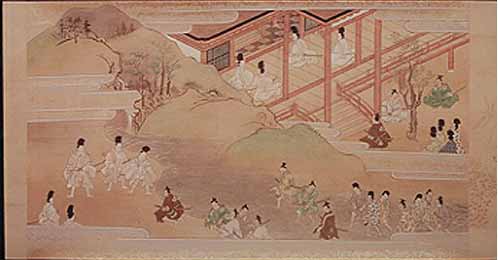 One May a strong gale hit Kyoto causing much
damage and killing many people. People who did not like
the Tairano family tyranny gossiped that more bad things
would happen. Tairano Shigemori heard of this, and
worried about the future of his family. He then decided
to make the Kumano Pilgrimage in spite of his illness. He
kept praying for his father Kiyomori and the Tairano
family all night long in front of the Kumano Gongen. He
finished his pilgrimage but the long trip to Kumano was
too much for him, and he died soon after that. This was
the beginning of the fall of the Tairano Family.
One May a strong gale hit Kyoto causing much
damage and killing many people. People who did not like
the Tairano family tyranny gossiped that more bad things
would happen. Tairano Shigemori heard of this, and
worried about the future of his family. He then decided
to make the Kumano Pilgrimage in spite of his illness. He
kept praying for his father Kiyomori and the Tairano
family all night long in front of the Kumano Gongen. He
finished his pilgrimage but the long trip to Kumano was
too much for him, and he died soon after that. This was
the beginning of the fall of the Tairano Family. 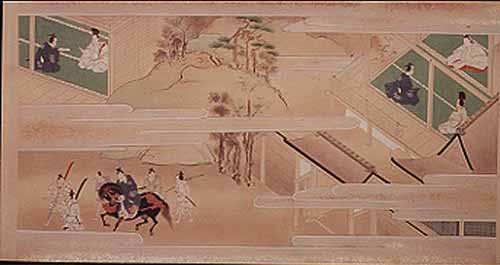 Mochihito Shinno, the second prince of Emperor
Goshirakawa, Minamotono Yorimasa, who decided to send a
message of provocation to the Genji clan all over Japan,
chose Shingu Juro Yoshimori as the messenger. Yoshimori,
who then lived in Kumano, was called to Kyoto, changed
his name to 'Yukiie', and thereafter left for the Eastern
provinces with Prince Shinno's message. Tanzo, the
Governor of Kumano, found this out and promptly informed
Kiyomori about Shinno's message, and proceeded to lead
1000 soldiers to the port of Shingu to beat Shingu and
Nachi who were on the side of Genji. But, unbeknownst to
them, 2000 soldiers were waiting for them in Shingu and
Nachi. Tanzo lost this battle, getting injured himself,
and made a narrow escape to Hongu.
Mochihito Shinno, the second prince of Emperor
Goshirakawa, Minamotono Yorimasa, who decided to send a
message of provocation to the Genji clan all over Japan,
chose Shingu Juro Yoshimori as the messenger. Yoshimori,
who then lived in Kumano, was called to Kyoto, changed
his name to 'Yukiie', and thereafter left for the Eastern
provinces with Prince Shinno's message. Tanzo, the
Governor of Kumano, found this out and promptly informed
Kiyomori about Shinno's message, and proceeded to lead
1000 soldiers to the port of Shingu to beat Shingu and
Nachi who were on the side of Genji. But, unbeknownst to
them, 2000 soldiers were waiting for them in Shingu and
Nachi. Tanzo lost this battle, getting injured himself,
and made a narrow escape to Hongu. 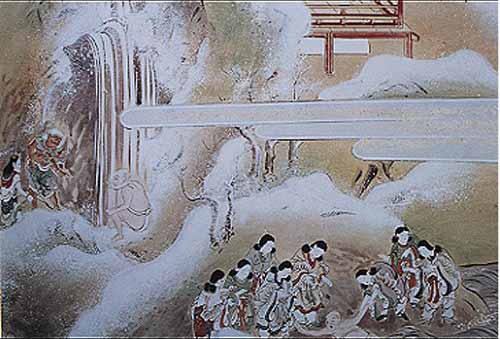 Endo Moritoh, a samurai of the Emperor's Palace,
became a monk, changed his name to Mongaku, and went on a
journey around Japan in order to pursue his spiritual
training. He visited Kumano and began to train himself in
Nachi Falls, famous as a place for severe spiritual
training. He entered the cold waters of the Nachi
waterfall and began to train himself with heart and soul
chanting endlessly an incantation of Fudomyo-o, but he
lost consciousness due to hypothermia. Then two children,
messengers of Fudomyo-o (one of Buddhism's guardian
spirits), appeared and pulled him out of the falls and
brought him back to life. After recovering, Mongaku went
on to finish his 21 days training in peace under the care
of Fudomyo-o. Later he visited all the training places
like Omine, Katsuragi, Fuji and further trained himself.
Endo Moritoh, a samurai of the Emperor's Palace,
became a monk, changed his name to Mongaku, and went on a
journey around Japan in order to pursue his spiritual
training. He visited Kumano and began to train himself in
Nachi Falls, famous as a place for severe spiritual
training. He entered the cold waters of the Nachi
waterfall and began to train himself with heart and soul
chanting endlessly an incantation of Fudomyo-o, but he
lost consciousness due to hypothermia. Then two children,
messengers of Fudomyo-o (one of Buddhism's guardian
spirits), appeared and pulled him out of the falls and
brought him back to life. After recovering, Mongaku went
on to finish his 21 days training in peace under the care
of Fudomyo-o. Later he visited all the training places
like Omine, Katsuragi, Fuji and further trained himself. 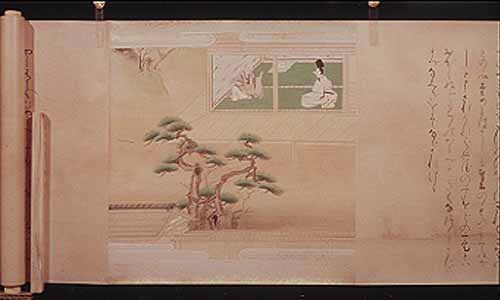 Mongaku, after finishing his spiritual training
all over Japan, built his hermitage in Mt. Takao and
gathered donations for renovating Jingoji Temple. One day
he visited the palace of Emperor Goshirakawa seeking a
donation, but he got himself into trouble with the guards
and got arrested. He was amnestied once, but was again
arrested and banished to Izu for preaching to his patrons
the downfall of the social order. He said, 'The world
will be corrupt and every one will be ruined.' Minamoto
no Yoritomo was also banished to Izu. Mongaku incessantly
urged Yoritomo to attack and beat the Heike clan, but
Yoritomo rejected his suggestion saying that he had no
proper reason for taking such an action. Mongaku later
received orders from Emperor Goshirakawa to attack the
Tairano family and relayed these orders to Yoritomo who,
at Mongaku's urging, finally joined him in the struggle
to bring down the Tairano family.
Mongaku, after finishing his spiritual training
all over Japan, built his hermitage in Mt. Takao and
gathered donations for renovating Jingoji Temple. One day
he visited the palace of Emperor Goshirakawa seeking a
donation, but he got himself into trouble with the guards
and got arrested. He was amnestied once, but was again
arrested and banished to Izu for preaching to his patrons
the downfall of the social order. He said, 'The world
will be corrupt and every one will be ruined.' Minamoto
no Yoritomo was also banished to Izu. Mongaku incessantly
urged Yoritomo to attack and beat the Heike clan, but
Yoritomo rejected his suggestion saying that he had no
proper reason for taking such an action. Mongaku later
received orders from Emperor Goshirakawa to attack the
Tairano family and relayed these orders to Yoritomo who,
at Mongaku's urging, finally joined him in the struggle
to bring down the Tairano family.  While Minamotono Yoritomo and Kiso Yoshinaka
were raising an army to defeat the Tairano family,
Kiyomori suddenly fell ill, became weaker day by day, and
eventually died. The Tale of Heike (the story of the
Tairano Family) describes Kiyomori's suffering as
follows: 'His fever is so hot that nobody can come close
to his bed. As soon as his fever-ridden body is soaked in
the cool water from Senjuin in Mt. Hiei, which is famous
for its cool water, the water boils at once. If the water
is poured over his body the water evaporates even before
it touches his body, if the water happens to touch his
body, the water burns in flames and its black smoke fills
up the room. This is just like being in Shonetsu Jigoku
(the hell of fire and heat).'
While Minamotono Yoritomo and Kiso Yoshinaka
were raising an army to defeat the Tairano family,
Kiyomori suddenly fell ill, became weaker day by day, and
eventually died. The Tale of Heike (the story of the
Tairano Family) describes Kiyomori's suffering as
follows: 'His fever is so hot that nobody can come close
to his bed. As soon as his fever-ridden body is soaked in
the cool water from Senjuin in Mt. Hiei, which is famous
for its cool water, the water boils at once. If the water
is poured over his body the water evaporates even before
it touches his body, if the water happens to touch his
body, the water burns in flames and its black smoke fills
up the room. This is just like being in Shonetsu Jigoku
(the hell of fire and heat).' 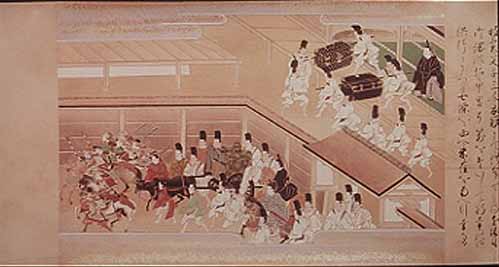 After Kiyomori's death, the power of the Tairano
family steadily declined and the people started to take
sides with Genji. Among them was Kiso Yoshinaka who, with
great vigor, beat the governor of Echigo very easily. The
Tairano family then sent its army of ten thousand
soldiers with Tairano Koremori as grand general to
Echigo. But they lost this important battle against the
brave Genji clan, and the Tairano clan was chased away
from Kyoto and toward the west by the forces of Kiso
Yoshinaka. They went all the way to Kyushu to build back
their strength only to find more people on the side of
the Genji clan. They then sailed their navy to Yashima by
way of the Inland Sea and became embroiled in yet another
battle.
After Kiyomori's death, the power of the Tairano
family steadily declined and the people started to take
sides with Genji. Among them was Kiso Yoshinaka who, with
great vigor, beat the governor of Echigo very easily. The
Tairano family then sent its army of ten thousand
soldiers with Tairano Koremori as grand general to
Echigo. But they lost this important battle against the
brave Genji clan, and the Tairano clan was chased away
from Kyoto and toward the west by the forces of Kiso
Yoshinaka. They went all the way to Kyushu to build back
their strength only to find more people on the side of
the Genji clan. They then sailed their navy to Yashima by
way of the Inland Sea and became embroiled in yet another
battle.  Tairano Koremori, Grand General of the Heike
clan, missing so much his wife and children, who were
left behind in Kyoto, fled from the battlefield of
Yashima with Shigekage, Ishidomaru and Toneri Takesato,
but they could not enter Kyoto because it was full of
soldiers loyal to the Genji clan. Reluctantly, they
decided to visit Takiguchi Nyudo on Mt. Koya. As he
talked with Takiguchi Nyudo, Koremori felt the urge to
escape from the delusion of this world. So he shaved his
head and became a monk with Chikaku Shonin as his master.
Shigekage and Ishidomaru also became monks, but Koremori
did not allow Takesato to become a monk because he wanted
him to go to Kyoto and relay the news of his decision to
his family in Kyoto and to the Heike clan in Yashima.
Tairano Koremori, Grand General of the Heike
clan, missing so much his wife and children, who were
left behind in Kyoto, fled from the battlefield of
Yashima with Shigekage, Ishidomaru and Toneri Takesato,
but they could not enter Kyoto because it was full of
soldiers loyal to the Genji clan. Reluctantly, they
decided to visit Takiguchi Nyudo on Mt. Koya. As he
talked with Takiguchi Nyudo, Koremori felt the urge to
escape from the delusion of this world. So he shaved his
head and became a monk with Chikaku Shonin as his master.
Shigekage and Ishidomaru also became monks, but Koremori
did not allow Takesato to become a monk because he wanted
him to go to Kyoto and relay the news of his decision to
his family in Kyoto and to the Heike clan in Yashima.  Tairano Koremori, now a monk, started for Kumano
remembering the time when he accompanied his father
Shigemori on his earlier Kumano Pilgrimage. After
becoming a monk, Tairano Kiyomori started for Kumano
dressed as a Yamabushi (Mountain Buddhist) with Takiguchi
Nyudo as his guide. He visited the Tsukumo Oji (99 Oji)
on the way and followed the Nakaheji Route from Tanabe to
Hongu. When he prayed in front of Shojoden, the main
building of the Kumano Hongu Shrine, he remembered the
time when he came here with his father and was overcome
with emotion. He then sailed down the Kumano River to
Shingu and visited Kumano Hayatama Grand Shrine, Kamikura
Shrine, Asuka Shrine, and Kumano Nachi Grand Shrine.
Tairano Koremori, now a monk, started for Kumano
remembering the time when he accompanied his father
Shigemori on his earlier Kumano Pilgrimage. After
becoming a monk, Tairano Kiyomori started for Kumano
dressed as a Yamabushi (Mountain Buddhist) with Takiguchi
Nyudo as his guide. He visited the Tsukumo Oji (99 Oji)
on the way and followed the Nakaheji Route from Tanabe to
Hongu. When he prayed in front of Shojoden, the main
building of the Kumano Hongu Shrine, he remembered the
time when he came here with his father and was overcome
with emotion. He then sailed down the Kumano River to
Shingu and visited Kumano Hayatama Grand Shrine, Kamikura
Shrine, Asuka Shrine, and Kumano Nachi Grand Shrine. 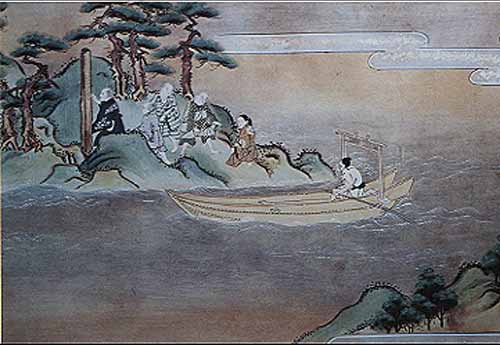 After visiting Nachi Shrine, Koremori an his
small party set out to sea in a small boat from
Hamanomiya. As they sailed out to sea, they chanted
loudly with their hands held together in prayer. They
then faced to the west and jumped into the sea and
drowned. It was then 1184. On a pine tree on one of the
local islands it was written: 'General Koremori, known
also as Joen the monk, entered the water in front of
Hamanomiya at the age of 27'.
After visiting Nachi Shrine, Koremori an his
small party set out to sea in a small boat from
Hamanomiya. As they sailed out to sea, they chanted
loudly with their hands held together in prayer. They
then faced to the west and jumped into the sea and
drowned. It was then 1184. On a pine tree on one of the
local islands it was written: 'General Koremori, known
also as Joen the monk, entered the water in front of
Hamanomiya at the age of 27'.